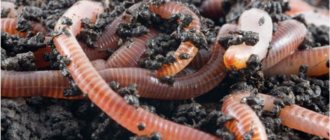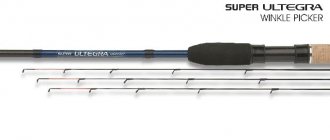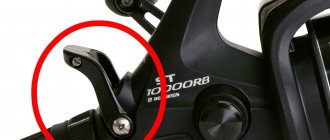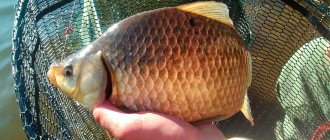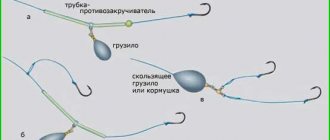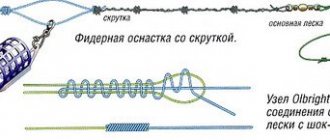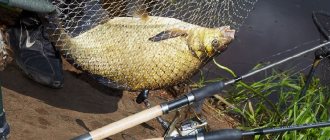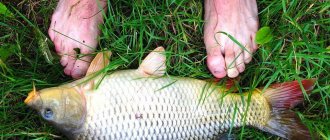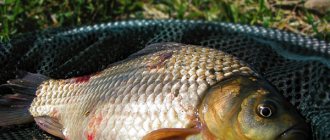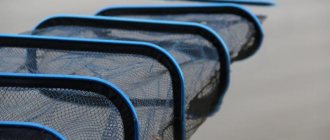The word “picker” often confuses fishing enthusiasts, although they are able to distinguish a feeder tackle from a fly rod. In fact, this is one tackle (feeder), only here there is a difference, as in a spinning rod. There are light and heavy, and there is ultralight.
Picker gear is a “light” direction of the feeder for working with relatively light loads and feeders. Properly installed equipment will provide excellent fishing both on a still body of water and with the current. In my opinion, a picker is a good solution for a beginner - a feeder, a bottom fisher, or a teenager who is addicted to fishing.
Initially, picker rods did not go beyond the 40 gram test. However, with the improvement of manufacturing materials, developers have made it possible for anglers to use larger weights, up to 120 grams, which blurs the line between these two directions. I will not consider modern “heavy” pickers in this review, but will touch on the classics of the genre - 40 - 60 grams.
So.
Picker rod
Picker rods are sticks with a small dough, in size not exceeding 3 meters and, as already mentioned, for fishing at distances of no more than 30 meters.
The “golden” standard is fishing rods 2.4 - 2.7 meters long with 40 grams of dough, which allows you to comfortably fish in almost any body of water.
Despite the fact that you can often find telescopic fishing rods in stores, I advise beginners to abandon them and look at rods that have plug connections.
The forms consist of 2 legs and one or more tips (quivertypes) included in the kit.
Since picker fishing is an active way to relax, you should definitely choose coal blanks. Lightweight and durable.
The tops can be “coal” and “glass”. The second option is closer to me. They are softer, more elastic and more sensitive to bite.
The picker's action ranges from slow to ultra-fast. For a beginner, I would recommend choosing a rod with a fast action. It makes casting easy and catching both small and large fish.
Picker selection
Among rods designed for bottom fishing, the picker, which differs from the feeder in its increased sensitivity and compactness, takes pride of place. A picker rod is suitable for fishing from the shore in a small body of water where long casting is not required. Picker has proven itself well in hunting roach, white bream, silver bream, bleak, and crucian carp.
Such a rod with the appropriate equipment will come to the aid of the fisherman in cases where casting feeder gear is too complicated by environmental conditions. Also, a picker is also a good alternative to a match-type float rod.
When choosing a picker rod, you need to understand that the picker is suitable for fishing with small loads (up to 50 grams) at a short distance from the shore. The picker is especially good for small fish, as it is very sensitive and perfectly transmits bites from even the smallest fish.
For more information about length, test, action, tips and other aspects of choosing pickers, read the article “How to choose a picker.” Also in the article you will find an interesting video review of an inexpensive picker rod from SALMO.
Coil
Everything is simple here. The picker reel is selected individually for the fishing rod. The selection criterion is the balance between rod and reel. The optimal size would be an inertia-free machine with a size of 1000 - 2000.
I'm sure you know how to check your balance. Having secured the reel in the reel seat, place the rod on your palm turned perpendicular to the floor with your fingers closed. If the set is balanced, it will lie parallel to the floor without overweight.
Picker reel
Reels for picker gear are used the same as for feeder fishing. But considering that the picker is designed for small fish, you can purchase lightweight models without a rear friction brake. For a fishing rod up to 2.7 m long, the optimal reel size will be 1500-2000, although it is worth checking the balance using the above method, but with a fixed reel. If the balance is off, you need to choose a lighter or heavier reel. A minor imbalance will not have a significant impact during recreational fishing, but for intensive sport fishing it is unacceptable.
Often anglers use fast match reels, which are considered universal for any fishing using light tackle.
fishing line
Under certain conditions, every angler prefers braided cord or monofilament line. Optimal for the main line is a monofilament with a diameter of 0.16 - 0.2 mm.
Fishing is carried out at short distances with minimal loads. Small fish are not a problem for a monk, and the stretchability of the fishing line and the adjustment of the entire set will allow you to bring a solid trophy to the shore.
For leashes, we use scaffolding 0.12 - 0.14 millimeters long. Naturally, high-quality.
A thin braided cord, as a basis, is used in difficult conditions of an overgrown reservoir.
Lure
It is necessary to remember about complementary feeding, let's talk about this in more detail.
Before you start fishing, you need to start feeding the point, after which you can wait some time and start fishing, during which you should regularly feed the point with small portions of bait for crucian carp. There are three ways to deliver food to the fishing point for pickerel fishing: • using a feeder; • throwing balls by hand; • using a slingshot. Using a feeder. For starter feeding, you can use a special high-capacity feeder. After splashing down, you need to let the line sag, after which you should make a sharp jerk with the rod so that the food spills out to the bottom and start reeling. After a series of casts to start feeding the point, you can set up a working feeder, which will be used during fishing, and start fishing, each time after reeling out the tackle, filling the feeder with a new portion of bait. Balls from your hand. It is necessary to form dense balls of about 10 - 12 cm in diameter from the soaked bait. The ability to accurately cast them comes with practice. It is better to throw the throw not from behind the head, but from the bottom up - this will allow you to place the balls more softly and avoid their premature destruction. With a slingshot. To cast with a slingshot, the bait must be rolled into balls with a diameter of about 5 cm. Each such ball is placed in the thicket of the slingshot, after which a shot is fired in the desired direction. The ability to place bait exactly in the fishing spot, again, comes with practice. As for the composition of the mixture, you can purchase ready-made feeder bait in the store or make it yourself. Crucian carp are well attracted to ordinary porridges flavored with flavors - vanilla, honey, strawberries, dill, garlic and others.
Picker feeder
There is an opinion among anglers that when fishing with pickerel, feeders are used only on the first casts, when it is necessary to feed the fishing point, and then a sinker is attached instead.
It is quite possible that in some conditions (on a stagnant body of water with overgrown vegetation) this will be true. But then, what’s stopping you from simply feeding the area with bait balls by hand or with a slingshot?
In my opinion, the feeder is as integral a part of the picker as its older brother, the feeder. Only here it is especially worth monitoring such parameters as weight, size and shape. Especially when fishing in the current. Not only the ballistic ability, but also the “resistance” to drift and fixation on the bottom will depend on the weight and shape of the feeder.
The most popular are feeders and weights weighing 20 - 25 grams of a cylindrical shape, made independently or factory-made. Metal or plastic.
Plastic containers are preferable.
When choosing a feeder and load, it is necessary to consider the fishing conditions - the depth of the point, the current or its absence. So does the type of intended prey. Fish have an ambiguous attitude towards objects splashing and sinking to the bottom, even if they carry food.
When fishing with pickerel, delicacy and minimal noise are the key to success.
Picker device
The picker fishing rod consists of the same elements as the feeder:
- rod;
- coil;
- main line;
- feeder (or sinker);
- leash;
- hook.
Typically, rods with a length of 2 to 3 m . Blanks are most often used with two-knees with a plug-in connection of the knees, with a test weight of up to 50 g. The rod comes with several interchangeable tips (quivertips) of varying hardness, which serve as bite alarms.
High-quality picker rods are made of high-modulus graphite. This form is light and elegant, and at the same time it can withstand landing a good carp.
Unlike feeders, which have long handles that allow long casts with two hands, picker blanks are often available with short handles. Such rods are most convenient for active fishing at short distances.
Picker has a number of advantages over other gear, which make it almost ideal gear for crucian carp fishing.
Advantages of a picker over a float rod:
- long-distance casting : a compact weight or picker feeder hardly floats when casting, which allows you to make precise casts over a distance of several tens of meters;
- the ability to fish in windy weather : even in a squally wind, you can make a good cast with a picker, and the tip of the rod will clearly show the bite, while there is nothing to do with a float in such weather on a pond;
- Convenience of feeding : the picker allows precise feeding of the selected fishing area, keeping the fish in one place.
Advantages of a picker over a feeder:
- compactness : pickers are convenient to use in places where casting with long rods is difficult (for example, if fishing is done from the shore covered with dense vegetation), on small ponds, channels and bays;
- lightness : crucian carp, especially large ones and when caught at relatively shallow depths, can be alarmed by the impact of a heavy feeder on the water, while a pickerel makes less noise when casting and is well suited for catching trophy specimens;
- sensitivity : the picker is good at showing cautious crucian bites; in addition, this tackle allows you to use the thinnest fishing lines and light, elegant equipment that will not scare off capricious fish.
A picker differs from a regular donkey in that it allows you to use a feeder instead of a sinker, thereby improving fishing performance, and involves more active, high-speed fishing.
Hooks
The main trophies are sorog, dace, crucian carp and bream. Taking this into account, the leading hooks are No. 10 - 16. If plant baits are used, hooks with a wide round bend are used. For animal baits - with an extended fore-end.
There are special hooks for the feeder on sale. They are made from thicker and stronger wire.
By and large, there is not much difference in what the hook is made for. The main thing to check when purchasing is the sharpness of the sting. You can check the sharpness by running a sting along your nail. The sharp hook leaves scratches with light pressure.
Selection of components and equipment
Vershinka . The colored tip is an important element of picker tackle, since it is the tip that acts as a bite indicator. On stagnant bodies of water, soft plastic quivertips are optimal, and hard coal ones are better suited for rivers, but crucian carp, as you know, usually stick to calm water.
Every fisherman should have a set of tips of different softness in his arsenal - usually it comes complete with a picker rod, but you can purchase quivertips separately.
Reel _ A spinning reel is ideal for picker fishing. It should be small and harmoniously combined with the fishing rod ( sizes 1500 - 2500 ). The friction brake can be adjusted at the rear or at the front, depending on the angler’s personal preferences. If
It is intended to fish with braid, the spool collar and the line roller must have a coating that can withstand the friction of the fishing line.
For picker fishing, you can use either a lightweight feeder reel with a baitrunner ( SHIMANO BAITRUNNER ST FB 2500, SHIMANO BAITRUNNER ST FA 2500 ) or a regular spinning reel with a rear drag ( Shimano Alivio 2500 RC ).
Fishermen also often use match reels for catching crucian carp, such as Mikado Ace Match 2006 FD . They lay thin line well and have a large gear ratio, which allows you to quickly reel in the gear (this is an important point in active picker fishing).
Fishing line . When catching this fish with pickerel, monofilament is often used. It is cheaper than braid and at the same time allows you to effectively catch fish at a short distance in the coastal zone, where pickerel fishing usually takes place. For catching crucian carp, monofilament with a thickness of 0.12 - 0.18 mm .
If you plan to make long casts, using monofilament, which stretches greatly, will noticeably reduce the sensitivity of the tackle and will make it difficult to control it. In this case, it is better to use braided wire.
Also, braided fishing line will be the best choice for fishing in heavily overgrown reservoirs , where many snags usually occur, since it has maximum strength with minimal thickness. For catching crucian carp with pickerel, a braid of 0.08 - 0.1 mm is suitable.
Feeder . In picker fishing, light spiral feeders weighing up to 15 - 20 g are used. The feeder must be selected so that, taking into account the weight of the bait, its weight does not exceed the upper limit of the rod test.
Since fishing usually takes place over a short distance, and picker feeders are small and have a small capacity, they are often not used at all. In this case, equipment with a sinker is used , and the point is fed with balls from the hand or using a slingshot.
Leash . For crucian carp fishing, which usually takes place in stagnant reservoirs, leashes up to 50 cm long are used. They can be made from braided wire, but to avoid frequent tangling of the leash over the fishing line during casting, it is better to use monofilament, which is more rigid.
Hooks . For catching crucian carp with pickerel, feeder hooks are best suited. If you use vegetable baits or small maggots, it is better to take so-called carp baits (with a short shank), and for fishing with a worm or a large sandwich with bloodworms and maggots , hooks with a long shank. The optimal size of hooks is selected taking into account the size of the intended trophies; numbers from 6 to 18 are usually used.
Equipment . The following can be considered an excellent picker rig for crucian carp:
- symmetrical loop;
- asymmetrical loop;
- Gardner's loop (paternoster).
Equipment using a symmetrical and asymmetrical loop quickly responds to a bite and does not sink in the silt, which makes catching crucian carp with them comfortable and effective. The Gardner loop provides excellent sensitivity and allows you to not miss even the most careful bite of this capricious fish.
You need to remember about complementary feeding , let's talk about this in more detail.
Fishing places . Before you start fishing, you need to start feeding the point, after which you can wait some time and start fishing, during which you should regularly feed the point with small portions of bait for crucian carp.
There are three ways to deliver food to the fishing point for pickerel fishing:
- using a feeder;
- throwing balls from your hand;
- using a slingshot.
Using a feeder . For starter feeding, you can use a special high-capacity feeder. After splashing down, you need to let the line sag, after which you should make a sharp jerk with the rod so that the food spills out to the bottom, and start reeling.
After a series of casts to start feeding the point, you can set up a working feeder, which will be used during fishing, and start fishing, each time after reeling out the tackle, filling the feeder with a new portion of bait.
Balls from your hand . It is necessary to form dense balls of about 10 - 12 cm in diameter from the soaked bait. The ability to accurately cast them comes with practice.
It is better to throw the throw not from behind the head, but from the bottom up - this will allow you to place the balls more softly and avoid their premature destruction.
Slingshot . To cast with a slingshot, the bait must be rolled into balls with a diameter of about 5 cm. Each such ball is placed in the thicket of the slingshot, after which a shot is fired in the desired direction. The ability to place bait exactly in the fishing spot, again, comes with practice.
As for the composition of the mixture , you can purchase ready-made feeder bait in the store or make it yourself.
Crucian carp are well attracted to ordinary porridges flavored with flavors - vanilla, honey, strawberries, dill, garlic and others.
Equipment for picker - Gardner paternoster and Inline
The main feature of the Gardner paternoster is its simplicity and reliability.
Offering to watch the installation of equipment is always better than forcing you to read. Therefore, I suggest that you watch the video with all the stages of manufacturing the Gardner paternoster and the In-Line feeder equipment.
The only moment. When describing the Carrot knot, the cone of the knot needs to be knitted in the opposite direction.
And in conclusion, an interesting video from a professional pickerel fisherman describing the main points of fishing.
NHNCH. Sergey K. Krasnoyarsk
Opinions between amateurs and professionals often differ. This is what feeder fishing pro Normunds Grabovskis said on the pages of salmoru:
Fishing for crucian carp with pickerel
Good day to you, dear fishermen.
Today I would like to talk about catching crucian carp with pickerel. Many will ask why you need to catch crucian carp with a pickerel when it already bites well on a fly rod? Everything is simple here, first of all, you don’t always want to get up early in the morning and go to the pond, because it is in the morning that crucian carp are most active. Secondly, there are reservoirs with overgrown banks, or a large abundance of duckweed, and sometimes there is simply nowhere to cast a simple fishing rod. Thirdly, for those who are just starting to fish with a picker, this is an excellent chance to hone their skills in casting accuracy and selection of feeders.
And in general, it’s better to watch the tip of the rod than to peer into the antenna of the float, which is barely visible in the middle of the reservoir. So, if I convinced you, then let's move on to the actual topic.
